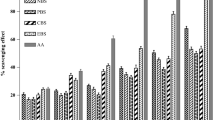Abstract
A novel gallate of tannin, (−)-epigallocatechin-(2β→O→7′,4β→8′)-epicatechin-3′-O-gallate (8), together with (−)-epicatechin-3-O-gallate (4), (−)-epigallocatechin (5), (−)-epigallocatechin-3-O-gallate (6), and (+)-gallocatechin-(4α→8′)-epigallocatechin (7), were isolated from the tea plant Camellia sinensis (L.) O. Kuntze var. sinensis (cv., Yabukita). The structure of 8, including stereochemistry, was elucidated by spectroscopic methods and hydrolysis. The compounds, along with commercially available pyrogallol (1), (+)-catechin (2), and (−)-epicatechin (3), were examined for toxicity towards egg-bearing adults of Caenorhabditis elegans. The anthelmintic mebendazole (9) was used as a positive control. Neither 2 nor 3 were toxic but the other compounds were toxic in the descending order 8, 7 ≈ 6, 9, 4, 5, 1. The LC50 (96 h) values of 8 and 9 were evaluated as 49 and 334 μmol L−1, respectively. These data show that many green tea polyphenols may be potential anthelmintics.


Similar content being viewed by others
References
Horton J (2003) Global anthelmintic chemotherapy programs: learning from history. Trends Parasitol 19:405–409
Kiuchi F, Tsuda Y, Kondo K, Yoshimura H, Nishioka I, Nonaka G (1988) Studies on crude drugs effective on visceral larva migrans III. The bursting activity of tannins on dog roundworm larva. Chem Pharm Bull 36:1796–1802
Yamasaki T, Sato M, Mori T, Mohamed ASA, Fujii K, Tsukioka J (2002) Toxicity of tannins towards the free-living nematode Caenorhabditis elegans and the brine shrimp Artemia salina. J Nat Toxins 11:165–171
Geary TG, Sangster NC, Thompson DP (1999) Frontiers in anthelmintic pharmacology. Vet Parasitol 84:275–295
Rand JB, Johnson CD (1995) Genetic pharmacology: interactions between drugs and gene products in Caenorhabditis elegans. In: Epstein HF, Shakes DC (eds) Methods in cell biology 48. Caenorhabditis elegans: modern biological analysis of an organism. Academic Press, San Diego, pp 187–204
Bennett JL, Pax RA (1986) Micromotility meter: an instrument designed to evaluate the action of drugs on motility of larval and adult nematodes. Parasitol 93:341–346
Simpkin KG, Coles GC (1981) The use of Caenorhabditis elegans for anthelmintic screening. J Chem Tech Biotechnol 31:66–69
Wood WB (1988) Introduction to C. elegans biology. In: Wood WB, the Community of C. elegans Researchers (eds) The nematode Caenorhabditis elegans. Cold Spring Harbor Laboratory Press, New York, pp 1–16
Barreiros ALBS, David JP, de Queiroz LP, David JM (2000) A-type proanthocyanidin antioxidant from Dioclea lasiophylla. Phytochemistry 55:805–808
Lewis JA, Fleming JT (1995) Basic culture methods. In: Epstein HF, Shakes DC (eds) Methods in cell biology 48. Caenorhabditis elegans: modern biological analysis of an organism. Academic Press, San Diego, pp 3–29
Mori T, Mohamed ASA, Sato M, Yamasaki T (2000) Ellagitannin toxicity in the free-living soil-inhabiting nematode, Caenorhabditis elegans. J Pestic Sci 25:405–409
Spence AM, Malone KMB, Novak MMA, Woods RA (1982) The effects of mebendazole on the growth and development of Caenorhabditis elegans. Can J Zool 60:2616–2623
Litchfield JT, Wilcoxon F (1949) A simplified method of evaluating dose effect experiments. J Pharmacol Exp Ther 96:99–113
Coxon DT, Holmes A, Ollis WD, Vora VC, Grant MS, Tee JL (1972) Flavanol digallates in green tea leaf. Tetrahedron 28:2819–2826
Foo LY, Porter LJ (1978) Prodelphinidin polymers: definition of structural units. J Chem Soc Perkin Trans 1:1186–1190
Jacques D, Haslam E, Bedford GR, Greatbanks D (1974) Plant proanthocyanidins Part II. Proanthocyanidin-A2 and its derivatives. J Chem Soc Perkin Trans 1:2663–2671
Fletcher AC, Porter LJ, Haslam E, Gupta RK (1977) Plant proanthocyanidins Part 3. Conformational and configurational studies of natural procyanins. J Chem Soc Perkin Trans 1:1628–1637
Barrett MW, Klyne W, Scopes PM, Fletcher AC, Porter LJ (1979) Plant proanthocyanodins. Part 6. Chiroptical studies Part 95. Circular dichroism of procyanidins. J Chem Soc Perkin Trans 1:2375–2377
Ma C-M, Nakamura N, Hattori M, Kakuda H, Qiao J-C, Yu H-I (2000) Inhibitory effects on HIV-1 protease of constituents from the wood of Xanthoceras sorbifolia. J Nat Prod 63:238–242
Hashimoto F, Nonaka G, Nishioka I (1989) Tannins and related compounds. XC. 8-C-Ascorbyl (−)-epigallocatechin 3-O-gallate and novel dimeric flavan-3-ols, oolonghomobisflavans A and B, from oolong tea (3). Chem Pharm Bull 37:3255–3263
Lou H, Yamazaki Y, Sasaki T, Uchida M, Tanaka H, Oka S (1999) A-type proanthocyanidins from peanut skins. Phytochemistry 51:297–308
Acknowledgments
We are grateful to Dr Masahiro Morokuma of Kagawa University for his identification of the plant material.
Author information
Authors and Affiliations
Corresponding author
Rights and permissions
About this article
Cite this article
Mukai, D., Matsuda, N., Yoshioka, Y. et al. Potential anthelmintics: polyphenols from the tea plant Camellia sinensis L. are lethally toxic to Caenorhabditis elegans . J Nat Med 62, 155–159 (2008). https://doi.org/10.1007/s11418-007-0201-4
Received:
Accepted:
Published:
Issue Date:
DOI: https://doi.org/10.1007/s11418-007-0201-4




